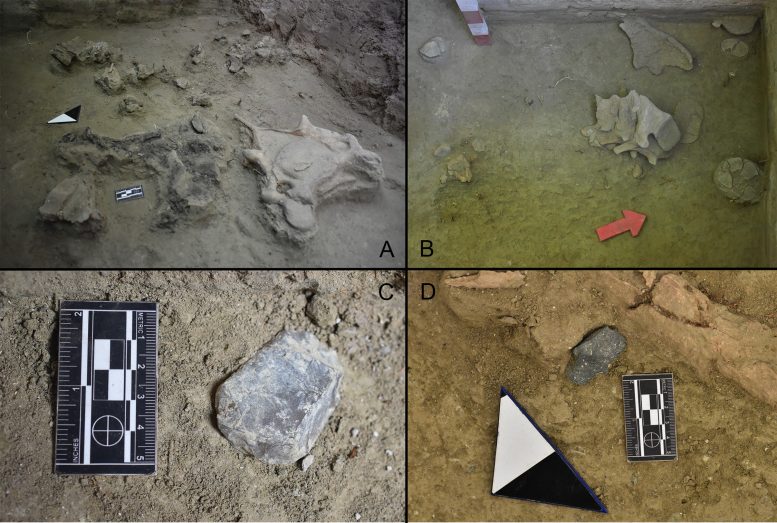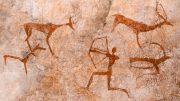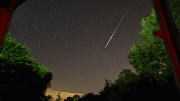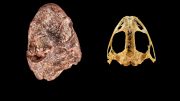
Photographs from TT-3. A. Combustion feature spatially associated with gomphothere cervical vertebrae and skull fragments (excavation unit C5); B. Sacral and caudal vertebrae, vertebral discs, and unfused coxal portions (excavation unit F5). Note the distance between the first sacral vertebra and its vertebral disc; C. End scraper (TT3-U1-N18) in situ (excavation unit 1); D. Core debitage (TT3-G5-N18-12) in situ spatially associated with gomphothere remains (excavation unit G5). Credit: Labarca et al., 2024, PLOS ONE, CC-BY 4.0
Temporary campsites indicate repeated visits by early hunter-gatherers.
Thousands of years ago, early hunter-gatherers frequently visited Tagua Tagua Lake in Chile to hunt prehistoric elephants and utilize the area’s resources, according to a study recently published in the journal PLOS ONE by Rafael Labarca and colleagues from the Pontifical Catholic University of Chile.
Multiple archaeological sites are known from the region of Tagua Tagua Lake in central Chile, representing some of the earliest known human settlements in the Americas. In this study, Labarca and colleagues report the recent discovery of a new site called Taguatagua 3, an ancient hunter-gatherer camp dating to the Late Pleistocene, between 12,440 and 12,550 years old.
Subsistence Strategies and Seasonal Occupancy
Notably, this site features the fossil remains of a gomphothere, an extinct relative of elephants. Signs of butchery on the bones, along with stone tools and other evidence, indicate that Taguatagua 3 represents a temporary camp established around the task of processing the large carcass. Other activities were also carried out during the camp’s brief period of use, including processing of other foods as indicated by additional charred remains of plants and small animals such as frogs and birds. Fossil cactus seeds and bird eggshells suggest that this camp was occupied specifically during the dry season.
Numerous such sites of similar age are now known from this region, implying that Tagua Tagua Lake was a recurring hunting and scavenging ground for people during the Late Pleistocene due to abundant and predictable local resources. The researchers suggest that this area was a key location along the routes taken by mobile communities of the time and that temporary camps might have hosted regular meetings between these mobile bands. Further investigation of this rich archaeological region will continue to provide insights into the mobility and subsistence strategies of early humans in South America.
The researchers add: “Taguatagua 3 helps us to understand better how the early humans adapted to fast-changing environments in central Chile during the late Pleistocene times.”
Reference: “Taguatagua 3: A new late Pleistocene settlement in a highly suitable lacustrine habitat in central Chile (34°S)” by Rafael Labarca, Matías Frugone-Álvarez, Liz Vilches, José Francisco Blanco, Ángela Peñaloza, Carolina Godoy-Aguirre, Álvaro Lizama-Catalán, Cristóbal Oyarzo, Carlos Tornero, Erwin González-Guarda, Ayelen Delgado, Marcela Sepúlveda and Paula Soto-Huenchuman, 22 May 2024, PLOS ONE.
DOI: 10.1371/journal.pone.0302465
This research was funded by ANID-FONDECYT Grants 11170919, 11220930, 1230860, Fundación Palarq Grant 2020-2022, and the Ilustre Municipalidad de San Vicente. Additional support was provided by FONDEQUIP EQM150101 (SEM-EDX) and FONDEQUIP EQM150020 (Confocal microscopy/RAMAN/AFM spectroscopy).









Be the first to comment on "Archaeologists Unearth Lost Camps of Chile’s Elephant Hunters"